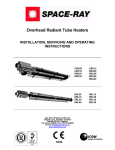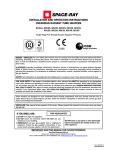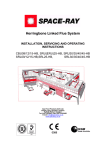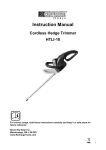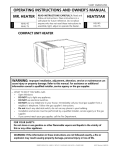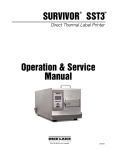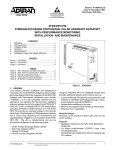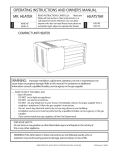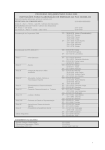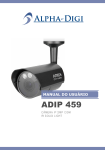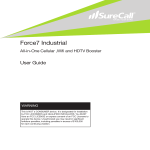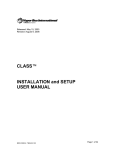Download Lennox International Inc. TUA100S User's Manual
Transcript
INSTALLATION INSTRUCTIONS Litho U.S.A. TUA*S(N,L)(A,S)F ©2003 *045, 060, 075, 100, and 125 Lennox Industries Inc. Dallas, Texas, USA T-CLASSTM SEPARATED COMBUSTION UNIT HEATERS Table Of Contents Unit Dimensions……………………………… 1, 2 Leak Check……………………………………….. 13 Shipping……………………………………… 3 Start-up Operation………………………………... 14 Requirements………………………………… 3 Heating Sequence of Operation………………… 16 Unit Heater Installation……………………… 4 Ignition Control LED……………………………… 16 Combustion Air………………… Ventilation 4 Adjustments…………………….…………………. 17 Venting………………………………………… 5 Service…………………………………………….. 19 Electrical Connections……………………… 12 Wiring Diagram………………….……………….. 20 Gas Connection……………………………… 13 & RETAIN THESE INSTRUCTIONS FOR FUTURE REFERENCE WARNING If the information in this manual is not followed exactly, a fire or explosion may result causing property damage, personal injury or loss of life. WHAT TO DO IF YOU SMELL GAS: Do not store or use gasoline or other flammable vapors and liquids in the vicinity of this or any other appliance. Installation and service must be performed by a qualified installer, service agency or the gas supplier. P/N: 065354800 • • • • • Do not try to light any appliance. Extinguish any open flame. Do not touch any electrical switch; do not use any phone in your building. Immediately call your gas supplier from a neighbor's phone. Follow the gas supplier's instructions. If you cannot reach your gas supplier; call the fire department. ORGINATED: 5/04 REVISED: 11/04 SUPERSEDES: NEW Technical literature form number 504,955M START-UP AND PERFORMANCE CHECK LIST Job Name:___________________ Job No.:_______________________ Date:_________________________ Job Location:_________________ City:__________________________ State/Province:_________________ Installer:_____________________ City:__________________________ State/Province:_________________ Unit Model No.:_______________ Serial No.:_____________________ Service Technician:______________ Electrical Connections Tight?______________________ Flue Connections Tight?__________________________ Supply Voltage_________________________________ Unit Operation Checked?__________________________ Gas Piping Connections Tight & Leak Tested?________ THERMOSTAT Motor Amps___________________________________ Calibrated?___________________________________ Unit BTU Input________________________________ Heat Anticipator Properly Set?___________________ Line Pressure__________________________________ Level?_______________________________________ Manifold Pressure___________________in. w. c. 45, 60, and 75 UNIT DIMENSIONS 13 (330) 7-1/4 (184) 3-1/4 (83) 13 (330) 7 (178) HANGING BRACKETS (2) 1 (25) 3 (76) MOUNTING SLOTS (Typical) 5/16 x 3 Inches (8 x 76 mm) 1/2 (13) DIMENSION 45 AIR FLOW 60/75 A 12 (305) 17 (432) B 5-1/2 (140) 6-1/2 (165) C 7-3/4 (197) 10-1/4 (260 D 1-3/4 (44) 3-1/4 (83) E 5-1/4 (133) 5-3/4 (146) 18-1/2 (470) HEAT EXCHANGER B 1 (25) TOP VIEW 18-1/2 (470) HANGING BRACKETS (2) GAS INLET 1 (25) 26 (660) 5-3/4 (146) ELECTRICAL BOX (60, 75) FLUE OUTLET A C E SITE GLASS ADJUSTABLE LOUVERS D THUMB SCREW COMBUSTION AIR INLET ELECTRICAL BOX (45) SIDE VIEW Page 1 BACK VIEW DIRECT DRIVE FAN 100 and 125 UNIT DIMENSIONS THREADED STUDS 5-1/2 (140) 24-7/16 (621) AIR FLOW 21-5/16 (541) 32-3/8 (822) HEAT EXCHANGER (ALUMINIZED STEEL) 7-1/4 (184) 1/2 (13) TOP VIEW 36-1/2 (927) 32-3/8 (822) 8-1/2 (216) THUMB SCREW 7-3/8 (187) DIRECT DRIVE FAN FLUE OUTLET ELECTRIC BOX 21 (533) 7 (178) ADJUSTABLE LOUVERS SITE GLASS SERVICE ACCESS DOOR 7-3/4 (197) GAS INLET SIDE VIEW COMBUSTION AIR INLET BACK VIEW TABLE 1 UNIT CLEARANCES Top Model TUA45S, TUA60S, TUA75S, TUA100S, TUA125S Sides Access Panel Bottom Rear Single Wall Vent* in mm in mm in mm in mm in mm in mm 1 25 1 25 18 457 0 0 18 457 6 152 *Except for listed clearance thimbles Page 2 Shipping Requirements – CSA in Canada The heater is completely assembled. Two mounting brackets are included with the 45, 60, and 75 size units. Check the unit for shipping damage. The receiving party should contact the last carrier immediately if any shipping damage is found. The instructions are intended only as a general guide and do not supersede local codes in any way. Authorities having jurisdiction should be consulted before installation. The installation must conform with local building codes or in the absence of local codes, with the current code CSAB149.1 “Installation Code for Natural Gas Burning Appliances and Equipment." All electrical wiring and grounding for the unit must also comply with the Canadian Electrical Code CSA C22.1, current edition. Requirements – CSA in the USA Installation of gas unit heaters must conform with local building codes or, in the absence of local codes, with the current National Fuel Gas Code ANSI Z223.1. Installation in aircraft hangers must be in accordance with the current Standard for Aircraft Hangers ANSI/NFPA No. 409. Installation in parking structures must be in accordance with the current Standard for Parking Structures ANSI/NFPA No. 88A. Installation in repair garages must be in accordance with the current Standard for Repair Garages ANSI/NFPA No. 88B. These units are approved for residential applications. Residential applications are defined as installations for heating non-living spaces that are attached to, adjacent to or part of a structure that contains space for family living quarters. For installation in a residential garage these units must be installed so that burners and ignition source are located no less than 18" (457mm) above floor. Heater must be located or protected to avoid physical damage by vehicles. Refer to the National Fuel Gas Code, ANSI Z223.1, current edition. Authorities having jurisdiction should be consulted before installation. The National Fuel Gas Code is available from: American National Standard Institute Inc. 11 West 42nd Street New York, NY 10036 These units are CSA International design certified. These unit heaters are certified for installation clearances to combustible material as listed in table 1 and on unit rating plate. Accessibility and service clearances must be observed in addition to fire protection clearances. All electrical wiring and ground for unit must be in accordance with the regulations of the current National Electric Code ANSI/NFPA No. 70. The National Electric Code is available from: National Fire Protection Association 1 Batterymarch Park PO Box 9101 Quincy, MA 02269-9101 Page 3 These unit heaters are CSA International certified for the clearances to combustible material listed on the rating plate and table 1. Adequate clearance shall be provided around the appliance and around air inlet terminals. Provision shall be made for service accessibility to the heater. Note that fire protection clearances may be exceeded to provide additional space for service and accessibility. GARAGE INSTALLATIONS: 1- In a storage area, clearance from heaters to combustible materials must be such that the material shall not attain a temperature above 160°F by continuous operation of the unit. 2- Eight foot minimum clearance from the floor to the bottom of the heater must be maintained. Refer to the CSA-B149 Codes. AIRCRAFT HANGER: 1- In an area where aircraft are housed or serviced, 10' minimum clearance from highest surface of aircraft to bottom of the heater must be maintained. 2- In other areas, 8' minimum clearance from the floor to bottom of heater must be maintained. 3- Heaters should be located so as to be protected from damage from aircraft or other appliances needed for servicing of aircraft. Refer to requirements of the enforcing authorities. RESIDENTIAL INSTALLATIONS: These units are approved for residential applications. Residential applications are defined as installations for heating non-living spaces that are attached to, adjacent to or part of a structure that contains space for family living quarters. For installation in a residential garage, these units must be installed so that burners and ignition source are located no less than 18" (457mm) above floor. Heater must be located or protected to avoid physical damage by vehicles. Refer to CSA-B149.1, current edition. Be sure to check with local codes and ordinances for additional requirements. . Secure mounting brackets to unit with retained screws. 6- To support unit, secure mounting bracket to ceiling joist or truss. Unit may also hang on rods as shown in figure 1. 100 and 125 size units may not be inverted, 3/8” X 16 threaded inserts are provided in the top the cabinet. Two threaded inserts are along one edge of the cabinet, two inserts are in the panel that divides the heat exchanger section from the control compartment. Unit Heater Installation INSTALL UNIT HEATER MOUNTING BRACKETS (45, 60, & 75 MODELS ONLY) SUPPORT RODS 1- Cut threaded rods to desired length and thread a 3/8” nut onto the rod. 2- Slide a flat washer onto the threaded rod AFTER the nut (7/16” I.D. X 1” O.D. X 1/16” THK washer). 3- Screw the rods (four) into the threaded inserts on the unit. 4- Tighten nuts to secure unit to rods. Combustion and Ventilation Air NORMAL POSITION (ABOVE) ALL MODELS MOUNTING BRACKETS (45, 60, &75 MODELS ONLY) Adequate facilities for supplying air for combustion and ventilation must be provided. All gas fired appliances require air to be used for the combustion process. If sufficient quantities of combustion air are not available, the heater or another appliance will operate in an inefficient manner, resulting in incomplete combustion which can result in the production of excessive carbon monoxide. SUPPORT RODS CAUTION - Insufficient combustion air can cause headaches, nausea, dizziness, asphyxiation or death. OPTIONAL INVERTED POSITION (ABOVE) 45, 60, AND 75 MODELS ONLY FIGURE 1 45, 60, and 75 size units may be installed in the normal position or inverted 180° as shown in figure 1 depending on desired location as governed by clearances, vent connection, air direction, gas supply, electrical supply and service accessibility. 1- Rotate louvers directing airflow as desired. 2- Choose location for mounting brackets. 3- Remove the mounting brackets from their shipping location (attached to the top of the unit) and replace the screws that held the brackets in their shipping location. 4- Remove and retain screws along top edge (bottom edge when inverted) of front of unit. 5- Align screw holes on mounting bracket with holes along top edge (either upright or inverted) of unit. Page 4 This unit must be provided with a combustion air pipe that is connected to the outside atmosphere. Outdoor air used for combustion must be free of the following substances or the life of the heat exchanger will be adversely affected: chlorine, carbon tetrachloride, cleaning solvent, halogen refrigerants, acids, cements and glues, printing inks, fluorides, paint removers, varnishes, or any other corrosives. TABLE 2 MAXIMUM HORIZONTAL VENT LENGTHS Model 45, 60, 75 100, 125 No. of Elbows Ft (M) Ft (M) 1 25 (7.6) 25 (7.6) 2 20 (6.1) 20 (6.1) 3 15 (4.6) 15 (4.6) 4 10 (3.0) 10 (3.0) 5 5 (1.5) 5 (1.5) Venting and Combustion Air Inlet A-General Recommendations and Requirements NOTE - The vent is a passageway, vertical or nearly so, used to convey flue gases from an appliance, or its vent connector, to the outside atmosphere. The vent connector is the pipe or duct that connects a fuel-gas burning appliance to a vent or chimney. The combustion air inlet is a pipe that connects the appliance to the outside atmosphere to convey oxygen from the air to the appliance burner. Unit heaters must be vented in compliance with all local codes or requirements of the local utility, the current standards of the (American) National Fuel Gas Code, ANSI Z223.1 or (Canada) CSA-B149 Installation Codes, and the following instructions. A vent connection flange and a combustion air pipe connection flange are attached to the back of the unit. Single wall vent material shall have all seams and joints sealed with pressure sensitive aluminum tape or silicone rubber sealant. Aluminum tape must meet the provisions of SMACNA AFTS-100-73 Standards. The aluminum tape has a temperature rating of 400°F (204°C). Silicone rubber sealant must have a temperature rating of 482°F (250°C), i.e., Dow Corning RTV-736 or equivalent. All joints shall be secured with at least two corrosion resistant screws. All joints must be checked for gas tightness after installation. Single wall vent shall not pass through any attic, interior wall, concealed space, or floor. B-Vertical Vents Using Metal Vent Pipe- Commercial and Residential Installations These separated combustion unit heaters are listed as Category I appliances for vertical vent installations. 1-These unit heaters are to be vented with NFPA- or ANSI- approved chimneys, U.L. listed type B-1 gas vents, single wall metal pipe, or listed chimney lining system for gas venting where applicable, as well as the modifications and limitations listed in figure 2. Seal single wall vent material according to the section A-General Recommendations and Requirements. Air inlet pipe may be single wall metal pipe or U.L. listed single wall metal flex connector. A concentric vent/adapter/cap kit as specified in these instructions may be used for vertical termination. Refer to table 3. 2- The vent connector shall be 3" (76mm) diameter on 45 units, 4" (100mm) diameter on 60/75 units, and 5” (127mm) on 100/125 units. The air inlet pipe shall 3- 4- 5- 6- 7- 8- 9- be 3” (76mm) diameter on 45 units and 4” (100mm) diameter on 60/75/100/125 units. Keep the vent and air inlet runs as short as possible with a minimum number of elbows. Refer to the (American) National Fuel Gas Code ANSI Z223.1 or (Canada) CSA-B149 Installation Code for maximum vent and vent connector lengths. Horizontal run of the vent connector from the induced draft blower to the chimney/vent cannot exceed the values in table 2. Single wall vent connector shall not be insulated. If a single wall vent is used in an unheated area it shall be insulated with a minimum of 1/2" thick foil faced fiberglass 1-1/2# density insulation. Failure to do so will result in condensation of flue gases. The unit may be vented vertically as a single appliance or as a common vent with other gas-fired appliances. In common venting situations, vent connectors for other appliances must maintain a 4" (100mm) vertical separation between the vent connectors. Refer to common venting tables in the (American) National Fuel Gas Code ANSI Z223.1 or (Canada) CSA-B149 Installation Code for proper vent size. Clearance to combustible material is 6" (152mm) for single wall vent material except where a listed clearance thimble is used. Clearance to combustible material for type B-1 vent or factory-built chimney is per manufacturer’s instructions. Clearance to combustible material is 1” on vertical sections of the concentric vent/adapter/cap kit. The vent connector shall be supported without any dips or sags. Vertical vents shall be supported in accordance with their listing and manufacturers’ instructions. All horizontal vent connector runs shall have a slope up to the vertical vent of at least 1/4" per foot (1mm per 50mm). All vertical type B-1 vents, single wall vents, or listed chimney lining system must be terminated with a listed vent cap or listed roof assembly. The vent must extend at least 3' (1m) above the highest point where it passes through a roof of a building and at least 2’ (0.6m) higher than any part of a building within a horizontal distance of 10' (3.05m) unless otherwise specified by the (American) National Fuel Gas Code, ANSI Z223.1 or (Canada) CSA-B149 Installation Codes. The vent must extend at least 5' (1.6m) above the highest connected equipment flue collar. Page 5 VENT AND AIR INTAKE TERMINATION ON SINGLE WALL VENT DOUBLE WALL (TYPE B-1) TERMINATION SINGLE WALL TERMINATION ROOF FLASHING ROOF FLASHING ROOF PITCHED FROM 0" TO 45" ROOF PITCHED FROM 0" TO 45" 12" MAX SHALL NOT BE A CONCEALED SPACE CLEARANCE TO BE AS SPECIFIED ON TYPE “B" VENT PIPE. SEAL JOINT BETWEEN SINGLE WALL VENT AND “B" VENT AND THE ANNULAR SPACE OF THE “B" VENT. 2" CLEARANCE THIMBLE FIGURE 2 used as an alternative to the thimble. When using a C-Horizontal Venting - General type B-1 vent termination use the clearances specified Common venting is not allowed with horizontal vent. by the vent manufacturer. Seal the connection The minimum horizontal vent length is three feet (914mm). between the single wall and double wall pipes and the 1- If possible, do not terminate the horizontal vent annular space of the double wall pipe as shown in through a wall that is exposed to prevailing wind. figure 2. Inside edge of vent termination tee or Exposure to excessive winds can affect unit Belmont cap must be at least 12 inches from outside performance. If such a termination is necessary, use a wall as shown in figure 3. wind block to protect the vent termination from direct 9- All horizontal vents must terminate with a tee or with a winds. cap as specified in table 4. Opening end of tee used 2- Vent termination must be free from obstructions and at for termination must face downward. Addition of ¼” least 12" (306mm) above grade level and maximum (6mm) mesh corrosion resistant material as a bird snow height. screen in the tee or cap openings may be used. 3- Do not terminate vent directly below roof eaves or 9- For horizontal venting, the vent pipe shall be above a walkway, or any other area where condensate supported with hangers no more than 3ft. (1m) apart dripping may be troublesome and may cause some to prevent movement after installation. staining. Avoid windows where steam may cause 10- Clearance to combustible material is 6" (152mm) for fogging or ice buildup. single wall vent material except where a listed 4- When horizontally vented, minimum clearance for clearance thimble is used. Clearance to combustible termination from any door, window, gravity air inlet, material for type B-1 vent or factory-built chimney is gas or electric meter, regulators, and relief equipment per manufacturer’s instructions. Clearance to is 4 ft. (1.2m) for U.S. installations. Refer to NFPA combustible material is 1” at the sides, 1” below, and 54/ANSI Z223.1 in the U.S.A. and CSA B149.1 and .2 3” above on horizontal installations of the concentric in Canada or with authorities having local jurisdiction. vent/adapter/cap kit In Canada, vent termination must have a minimum 6 ft. (1.8mm) horizontal clearance from gas and electric meters and relief devices as specified in the Canadian D-Horizontal Venting-Commercial B149.1, Natural Gas Installation Code. 1- Horizontal commercial installations are for buildings that are not attached to living spaces. The vent may 5- Vent termination must be a minimum of 4' (1.2m) be single wall vent material installed according to below or 4’ (1.2m) horizontally from any soffit vent or the sections Venting A-General under-eave vent. Recommendations and Requirements and C6- Vent must be a minimum of 6' from an inside corner Horizontal Venting - General and D-Horizontal formed by two exterior walls. If possible, leave a 10' Venting - Commercial. Refer to figures 3, 4, and 5. clearance. The air inlet may be single wall vent material or U.L. 7- Vent termination must be a minimum of 10' (3m) from listed single wall flex connector. any forced air inlet (includes fresh air inlet for other 2- Refer to table 2 for maximum vent lengths. The vent appliances, such as a dryer). pipe diameter for horizontal commercial installations 8- When termination is routed through an exterior shall be 3” (76mm) on 45 units, 4” (100mm) on combustible wall the vent must be supported using a 60/75 units, 5” (127mm)on 100/125 units. listed clearance thimble. Where local authorities permit, a single section of type B-1 vent pipe may be Page 6 stainless steel. Seal single wall vent material according to the section A-General Recommendations and Requirements. Condensate drainage can be collected in a tee pipe section (figure 4) or allowed to drip through the vent termination, if permitted by local authorities (figure 5). 5- For upward sloped vent a condensate tee and drain must be installed within the first 5’ (1.5m) from the unit heater to protect the appliance. If a flexible condensate drain line is used, the drain line must include a loop filled with water to prevent combustion products from entering the structure. If the unit is shut down for an extended period of time and will be exposed to sub-freezing temperatures, the condensate may freeze. 3- The air inlet diameter shall be 3” (76mm) on 45/60/75 units and 4” (100mm) on 100/125 units. Refer to table 4 for diameter and termination requirements. 4- Select a wall termination point that will maintain ¼” rise per foot slope of horizontal run of vent pipe. The vent may be single wall material minimum 26 GSG (0.46mm) galvanized steel or equivalent grade stainless steel. Seal single wall vent material according to the section A-General Recommendations and Requirements. In areas where local authorities having jurisdiction permit, a downward slope of maximum ¼” per foot is also acceptable. In such cases, the vent must be listed special vent for Category III appliances or single wall vent pipe constructed of number 26 GSG (0.46mm) galvanized steel or equivalent grade CONDENSATE DRAIN THROUGH TEE PIPE AND DRAIN LOOP UPWARD SLOPE ON HORIZONTAL VENT-COMMERCIAL INSTALLATION MAY BE SINGLE WALL (26 GSG) GALV. OR EQUIVALENT STAINLESS STEEL SEALED ACCORDING TO THESE INSTALLATION INSTRUCTIONS. SLOPE:+ 1/4 INCH FOR 1 FOOT RUN MINIMUM. 12” (30.5 CM) MIN. FROM WALL TO VENT TERMINATION VENT TERMINATION (TERMINATIONS MAY USE WIRE MESH BIRD SCREEN) 12” (30.5 CM) MIN. FROM AIR INLET TO VENT TERMINATION (MAY BE HORIZONTAL OR VERTICAL CLEARANCE) 12” (30.5 CM) MINIMUM ABOVE HIGHEST SNOWFALL LISTED THIMBLE THROUGH COMBUSTIBLE WALL AIR INLET TERMINATION GROUND LEVEL DRAIN LOOP WITH WATER TRAP (TO CONDENSATE DRAIN) NOTE - MINIMUM HORIZONTAL LENGTH 3 FT. (91.4 CM) NOT INCLUDING TERMINATION. REFER TO TABLE 2 FOR MAXIMUM LENGTH AND NUMBER OF ELBOWS. COMMON VENTING NOT ALLOWED WHEN HORIZONTALLY VENTING THE UNIT HEATER. FIGURE 3 Venting Concentric Kit - Commercial. The air inlet may be single wall material or U.L. listed single wall flex vent connector. 2-The vent pipe diameter for horizontal commercial installations shall be 3” (76mm) on 45 units and 4” (100mm) on 60/75 units. Refer to table 4. 3-Refer to table 2 for maximum vent lengths. 4-Refer to figure 7 for kit termination, figure 3 for upward slope with condensate trap, figure 4 for downward slope with trap, and figure 5 for downward slope with condensate drain through cap where permitted by local authorities. E-Horizontal Venting Concentric Kit - Commercial 1-Horizontal commercial installations are for buildings that are not attached to living spaces. The only concentric vent/adapter/cap kit that may be used is the kit supplied by Lennox Industries. The kit may be used with 45/60/75 units. The vent used to connect from the concentric adapter to the unit may be single wall material minimum 25 GSG (0.46mm) galvanized steel or equivalent grade stainless steel installed according to the sections Venting AGeneral Recommendations and Requirements and C-Horizontal Venting General and DHorizontal Venting–Commercial and E-Horizontal Page 7 CONDENSATE DRAIN THROUGH TEE PIPE AND DRAIN LOOP DOWNWARD SLOPE ON HORIZONTAL VENT-COMMERCIAL INSTALLATION MAY BE SINGLE WALL (26 GSG) GALV. OR EQUIVALENT STAINLESS STEEL SEALED ACCORDING TO THESE INSTALLATION INSTRUCTIONS. SLOPE: - 1/4 INCH FOR 1 FOOT RUN MINIMUM. 12” (30.5 CM) MIN. FROM WALL TO VENT TERMINATION AIR INLET TERMINATION VENT TERMINATION 12” (30.5 CM) MIN. FROM AIR INLET TO VENT TERMINATION (MAY BE HORIZONTAL OR VERTICAL CLEARANCE) LISTED THIMBLE THROUGH COMBUSTIBLE WALL DRAIN LOOP WITH WATER TRAP (TO CONDENSATE DRAIN) 12” (30.5 CM) MINIMUM ABOVE HIGHEST SNOWFALL NOTE - MINIMUM HORIZONTAL LENGTH 3 FT. (91.4 CM) NOT INCLUDING TERMINATION. REFER TO TABLE 2 FOR (TERMINATIONS MAY MAXIMUM LENGTH AND NUMBER OF ELBOWS. USE WIRE MESH BIRD GROUND LEVEL SCREEN) COMMON VENTING NOT ALLOWED WHEN HORIZONTALLY VENTING THE UNIT HEATER. FIGURE 4 CONDENSATE DRAIN THROUGH VENT TERMINATION DOWNWARD SLOPE ON HORIZONTAL VENT-COMMERCIAL INSTALLATION MAY BE SINGLE WALL (26 GSG) GALV. OR EQUIVALENT STAINLESS STEEL SEALED ACCORDING TO THESE INSTALLATION INSTRUCTIONS. SLOPE: - 1/4 INCH FOR 1 FOOT RUN MINIMUM. 12” (30.5 CM) MIN. FROM WALL TO VENT TERMINATION AIR INLET TERMINATION VENT TERMINATION 12” (30.5 CM) MIN. FROM AIR INLET TO VENT TERMINATION (MAY BE HORIZONTAL OR VERTICAL CLEARANCE) LISTED THIMBLE THROUGH COMBUSTIBLE WALL 12” (30.5 CM) MINIMUM ABOVE HIGHEST SNOWFALL NOTE - MINIMUM HORIZONTAL LENGTH 3 FT. (91.4 CM) NOT INCLUDING TERMINATION. REFER TO TABLE 2 FOR MAXIMUM LENGTH AND NUMBER OF ELBOWS. (TERMINATIONS MAY USE WIRE MESH BIRD GROUND LEVEL SCREEN) COMMON VENTING NOT ALLOWED WHEN HORIZONTALLY VENTING THE UNIT HEATER. FIGURE 5 Page 8 TABLE 3 VERTICAL VENT REQUIREMENTS VENT CAP OTHER 3” AIR INLET DIA. 3” U.L. APPROVED MAY USE ONE SECTION OF BVENT 3” 3” U.L. APPROVED 3” 3” 4” 4” 4” CONCENTRIC VENT/ ADAPTER/CAP KIT REQUIRED U.L. APPROVED 4” 4” U.L. APPROVED 4” 4” 5” 4” 4” CONCENTRIC VENT/ ADAPTER/CAP KIT REQUIRED U.L. APPROVED 5” 4” U.L. APPROVED 5” 4” 5” CONCENTRIC VENT/ ADAPTER/CAP KIT REQUIRED MODEL INSTALLATION FLUE TYPE AIR INLET TYPE FLUE DIA. 45 COMMERCIAL or RESIDENTIAL COMMERCIAL or RESIDENTIAL COMMERCIAL or RESIDENTIAL COMMERCIAL or RESIDENTIAL COMMERCIAL or RESIDENTIAL COMMERCIAL or RESIDENTIAL COMMERCIAL or RESIDENTIAL COMMERCIAL or RESIDENTIAL COMMERCIAL or RESIDENTIAL SINGLE WALL SINGLE WALL or METAL FLEX VENT TYPE B VENT SINGLE WALL or METAL FLEX VENT CONCENTRIC SINGLE WALL or METAL FLEX VENT SINGLE WALL SINGLE WALL or METAL FLEX VENT TYPE B VENT SINGLE WALL or METAL FLEX VENT CONCENTRIC SINGLE WALL or METAL FLEX VENT SINGLE WALL SINGLE WALL or METAL FLEX VENT TYPE B VENT SINGLE WALL or METAL FLEX VENT CONCENTRIC SINGLE WALL or METAL FLEX VENT 45 45 60, 75 60, 75 60, 75 100, 125 100, 125 100, 125 MAY USE ONE SECTION OF BVENT MAY USE ONE SECTION OF BVENT HORIZONTAL VENTING - RESIDENTIAL INSTALLATION UPWARD SLOPE MAY BE SINGLE WALL (26 GSG) GALV. OR EQUIVALENT STAINLESS STEEL SEALED ACCORDING TO THESE INSTALLATION INSTRUCTIONS OR A SINGLE SECTION OF TYPE B-1 VENT. SLOPE:+ 1/4 INCH FOR 1 FOOT RUN MINIMUM. 12” (30.5 CM) MIN. FROM WALL TO VENT TERMINATION VENT TERMINATION (TERMINATIONS MAY USE WIRE MESH BIRD SCREEN) 12” (30.5 CM) MIN. FROM AIR INLET TO VENT TERMINATION (MAY BE HORIZONTAL OR VERTICAL CLEARANCE) 12” (30.5 CM) MINIMUM ABOVE HIGHEST SNOWFALL LISTED THIMBLE THROUGH COMBUSTIBLE WALL AIR INLET TERMINATION NOTE - MINIMUM HORIZONTAL LENGTH 3 FT. (91.4 CM) NOT INCLUDING TERMINATION. MAXIMUM HORIZONTAL VENT LENGTH 5 FT. (1.5M) PLUS ONE 90-DEGREE ELBOW. GROUND LEVEL COMMON VENTING NOT ALLOWED WHEN HORIZONTALLY VENTING THE UNIT HEATER. FIGURE 6 Page 9 2-The vent pipe diameter for horizontal residential installations shall be 4” (100mm) on 45 units and 5” (127mm) on 60/75/100/125 units. Refer to table 4 for vent diameter and termination requirements. 3-The maximum vent length is 5’ (1.5m) plus one 90degree elbow. 4-The vent must maintain a ¼” rise per foot of slope upwards toward the termination F-Horizontal Venting-Residential Two Pipes 1-For horizontal residential installations these units are certified as Category I appliances. The vent may be single wall material minimum 25 GSG (0.46mm) galvanized steel or equivalent grade stainless steel or a single section of type B-1 vent installed according to the sections Venting A-General Recommendations and Requirements and C-Horizontal Venting General and F-Horizontal Venting–Residential Two Pipes. Refer to figure 6. TABLE 4 HORIZONTAL VENT REQUIREMENTS MODEL INSTALLATION FLUE TYPE AIR INLET TYPE 45 RESIDENTIAL SINGLE WALL 45 RESIDENTIAL 45 COMMERCIAL 45 COMMERCIAL 60, 75 RESIDENTIAL 60, 75 RESIDENTIAL 60, 75 COMMERCIAL FLUE DIA. INLET AIR DIA. 4” SINGLE WALL PIPE or METAL FLEX VENT CONCENTRIC SINGLE WALL PIPE or METAL FLEX VENT SINGLE WALL 3” SINGLE WALL PIPE or METAL FLEX VENT CONCENTRIC SINGLE WALL PIPE or METAL FLEX VENT SINGLE WALL 3” SINGLE WALL PIPE or METAL FLEX VENT CONCENTRIC SINGLE WALL PIPE or METAL FLEX VENT SINGLE WALL 4” 4” 4” 3” 3” 3” 3” 5” 4” 4” 4” 60, 75 COMMERCIAL 100, 125 RESIDENTIAL SINGLE WALL PIPE or METAL FLEX VENT CONCENTRIC SINGLE WALL PIPE or METAL FLEX VENT SINGLE WALL 4” COMMERCIAL SINGLE WALL PIPE or METAL FLEX VENT SINGLE WALL SINGLE WALL PIPE or METAL FLEX VENT 4” 100, 125 4” 4” 5” 5” Page 10 VENT CAP INLET AIR CAP TEE or 4” BELMONT TEE or 3” BELMONT 4” CONCENTRIC VENT/ ADAPTER/CAP KIT REQUIRED TEE or 3” BELMONT TEE or 3” BELMONT 4” CONCENTRIC VENT/ ADAPTER/CAP KIT REQUIRED TEE or 5” BELMONT TEE or 4” BELMONT 4” CONCENTRIC VENT/ ADAPTER/CAP KIT REQUIRED TEE or 4” BELMONT TEE or 4” BELMONT 4” CONCENTRIC VENT/ ADAPTER/CAP KIT REQUIRED TEE or 5” BELMONT TEE or 4” BELMONT TEE or 5” BELMONT TEE or 4” BELMONT MAX. VENT LENGTH (MIN. VENT LENGTH 3’) 5’ MAY USE ONE SECTION OF B-VENT 5’ 25’ MAY USE ONE SECTION OF B-VENT 25’ 5’ MAY USE ONE SECTION OF B-VENT 5’ 25’ MAY USE ONE SECTION OF BVENT 25’ 5’ MAY USE ONE SECTION OF B-VENT 5’ MAY USE ONE SECTION OF B-VENT G-Horizontal Venting Concentric Kit - Residential 1-For horizontal residential installations the 45/60/75 units are certified as Category I appliances with a concentric vent/adapter/cap kit. The only concentric vent/adapter/cap kits that may be used are the kits supplied by Advanced Distributor Products. The vent used to connect from the concentric adapter to the unit may be single wall material minimum 25 GSG (0.46mm) galvanized steel or equivalent grade stainless steel installed according to the sections Venting A - General Recommendations and Requirements and C - Horizontal Venting General and G - Horizontal Venting Concentric Kit Residential. Refer to figure 7. The air inlet may be single wall material or U.L. listed single wall flex vent connector. 2-The vent pipe diameter for horizontal residential installations shall be 4” (100mm) on 45/60/75 units. Refer to table 4. 3-The maximum vent length is 5’ (1.5m) plus one 90degree elbow. 4-The vent must maintain a ¼” rise per foot of slope upwards toward the termination. HORIZONTAL VENTING – CONCENTRIC VENT INSTALLATION VENT AND AIR INLET CONNECTORS FROM UNIT TO CONCENTRIC ADAPTER MAY BE SINGLE WALL (26 GSG) GALV. OR EQUIVALENT STAINLESS STEEL SEALED ACCORDING TO THESE INSTALLATION INSTRUCTIONS. SLOPE VENT + 1/4 INCH FOR 1 FOOT RUN MINIMUM. AIR INLET MAY ALSO BE U.L. LISTED SINGLE WALL FLEX VENT CONNECTOR. VENT TERMINATION AND AIR INLET TERMINATION 12” (30.5 CM) MINIMUM ABOVE HIGHEST SNOWFALL LISTED THIMBLE THROUGH COMBUSTIBLE WALL NOTE - MINIMUM HORIZONTAL LENGTH 3 FT. (91.4 CM) NOT INCLUDING TERMINATION. GROUND LEVEL COMMON VENTING NOT ALLOWED WHEN HORIZONTALLY VENTING THE UNIT HEATER. FIGURE 7 H-Removal Of Unit From Common Vent In the event that an existing unit heater is removed from a venting system commonly run with separate gas appliances, the venting system is likely to be too large to properly vent the remaining attached appliances. The following test should be conducted while each appliance is in operation and the other appliances are not in operation, yet remain connected to the common venting system. If the venting system has been installed improperly, the system must be corrected. 1- Seal any unused openings in the common venting system. 3- In so far as is practical, close all building doors and windows and all doors between the space in which the appliances remaining connected to the common venting system are located and other spaces of the building. Turn on clothes dryers and any appliances not connected to the common venting system. Turn on any exhaust fans, such as range hoods and bathroom exhausts, so they will operate at maximum speed. Do not operate a summer exhaust fan. Close fireplace dampers. 4- Follow the lighting instructions. Place the appliance being inspected in operation. Adjust thermostat so appliance will operate continuously. 5- Test for spillage at the draft hood relief opening after five minutes of main burner operation. Use the flame of a match or candle, or smoke from a cigarette, cigar, or pipe. 2- Visually inspect the venting system for proper size and horizontal pitch. Determine there is no blockage or restriction, leakage, corrosion, or other deficiencies which could cause an unsafe condition. Page 11 Electrically ground unit in accordance with local codes or, in the absence of local codes, in accordance with the current National Electrical Code (ANSI/NFPA No. 70) in the U.S.A., and in Canada with the current Canadian Electrical Code, Part 1 (CSA C22.1). 6- After it has been determined that each appliance remaining connected to the common venting system properly vents when tested as outlined above, return doors, windows, exhaust fans, fireplace dampers and any other gas-burning appliance to their previous condition of use. Make line voltage connections as shown in figure 8. Connect field wiring as shown on wiring diagram on unit. Also refer to typical diagram in this manual. An additional thermostat wire must be run to terminal “G" on heater when continuous blower is desired. 7- If improper venting is observed during any of the above tests, the common venting system must be corrected. The common venting system should be resized to approach the minimum size as determined by using the appropriate tables in Appendix G in the current standards of the National Fuel Gas Code, ANSI Z223-1 in the U.S.A. and the appropriate Category I Natural Gas and Propane appliances venting sizing tables in the current standards of the CSA-B149.1 and .2 in the Natural Gas and Propane Installation Code in Canada. LINE VOLTAGE FIELD WIRING UNIT ELECTRICAL BOX L1 NOTE - Local codes may supersede any of the above provisions. BLACK N WHITE Electrical Connections NOTE - These unit heaters use a direct spark ignition system. There is no pilot necessary as the spark lights the main burner as the gas valve is turned on. The direct spark ignition control board emits radio noise as the sparking process is underway. The level of energy may be sufficient to disturb a logic circuit in a microprocessor controlled thermostat. It is recommended that an isolation relay be used when connecting the unit heaters to a microprocessor controlled thermostat. Install the thermostat according to instructions provided. Select circuit protection and wire size according to the unit rating plate. Install a separate disconnect switch (protected by either fuse or circuit breaker) near the unit so that power can be turned off for servicing. Connect wiring through knockout on the junction box located on the side of the unit heater. Refer to heater wiring diagram for connection information. Use 18 gauge wire or larger for thermostat connections. FIGURE 8 Page 12 Gas Connection Leak Check When connecting gas supply, the length of the run from the meter must be considered in determining the pipe size. A line pressure of 7" w.c. (1.74 kPa) for natural gas should be maintained when sizing piping. A line pressure of 13” w.c. (3.23 kPa) should be maintained for liquefied petroleum (LP) gas. A minimum of 5.0" w.c. for natural gas or 10.4" w.c. for LP/propane gas should be maintained for proper unit operation. For correct sizing of piping, refer to the (American) National Fuel Gas Code ANSI Z223.1 or (Canada) CSA-B149 Installation Code or consult the utility having jurisdiction. After gas piping is completed, carefully check all piping connections, (field and factory), for gas leaks. Use a soap solution or other preferred means. A drip leg should be installed in the vertical pipe run to the unit. In some localities, codes may require that a manual main shutoff valve and union (furnished by installer) be installed external to the unit. Union must be of the ground joint type. A drip leg should be readily accessible to permit cleaning and emptying. See figure 9. Leave a minimum of 4" (102mm) clearance between electric box and drip leg. A 1/8" NPT plugged tap shall be installed immediately upstream of the gas supply connection to the heater. CAUTION - DO NOT use matches, candles, flame or other sources of ignition to check for gas leaks. IMPORTANT - The heater and its individual shut off valve must be disconnected from the gas supply piping system during any pressure testing of that system at test pressures in excess of 1/2 psig (3.45kPa). The appliance must be isolated from the gas supply piping system by closing its individual manual gas shutoff valve during any pressure testing of the gas supply system at test pressures equal to or less than 1/2 psig (3.45kPa). See figure 10. NOTE - In case emergency shutdown is required, shut down main gas valve and disconnect main power to unit. These devices should be properly labeled by the installer. NOTE - Compounds used on threaded joints of gas piping must be resistant to the actions of liquefied petroleum gases. GAS SUPPLY TO UNIT HEATER MANUAL MAIN SHUT-OFF VALVE WILL NOT HOLD NORMAL TEST PRESSURE GAS SUPPLY CONNECTION CAP MANUAL MAIN SHUT-OFF VALVE (Furnished by Installer) UNIT HEATER FIGURE 10 GROUND JOINT UNION 1/8 NPT PLUGGED TAP GAS FLOW DRIP LEG FIGURE 9 Page 13 ISOLATE GAS VALVE START-UP AND OPERATION Operation for Honeywell VR8205 Series Gas Valve (Figure 11) 1- STOP! Read the safety information at the beginning of this section. 2- Set thermostat to lowest setting. Unit Start-Up FOR YOUR SAFETY READ BEFORE LIGHTING ! WARNING 1HONEYWELL VR8205 SERIES GAS VALVE Electric shock hazard. Can cause injury or death. Do not use this heater if any part has been under water. Immediately call a qualified service technician to inspect the furnace and to replace any part of the control system and any gas control which has been under water. MANIFOLD PRESSURE ADJUSTMENT SCREW MANIFOLD PRESSURE TAP ! WARNING Danger of explosion. Can cause injury or product or property damage. If overheating occurs or if gas supply fails to shut off, shut off the manual gas valve to the appliance before shutting off electrical supply. ON OFF INLET PRESSURE TAP ! WARNING GAS VALVE SHOWN IN OFF POSITION FIGURE 11 Electric shock hazard. Can cause injury or death. Before attempting to perform any service or maintenance, turn the electrical power to unit OFF at disconnect switch(es). Unit may have multiple power supplies. ! WARNING Danger of explosion and fire. Can cause injury or product or property damage. You must follow these instructions exactly. BEFORE LIGHTING smell all around the appliance area for gas. Be sure to smell next to the floor because some gas is heavier than air and will settle on the floor. Use only your hand to push in or turn the gas control knob. Never use tools. If the knob will not push in or turn by hand, do not try to repair it, call a qualified service technician. Force or attempted repair may result in a fire or explosion. These unit heaters are equipped with an automatic spark ignition system. There is no pilot. In case of a safety shutdown, move thermostat switch to OFF, then return the thermostat switch to HEAT position. Page14 3-Turn off all electrical power to appliance. 4-This appliance is equipped with an ignition device which automatically lights burners. DO NOT attempt to light the burners manually. 5-Turn the manual knob on gas valve clockwise to OFF. Do not force. 6-Wait five (5) minutes to clear out any gas. If you then smell gas, STOP! Immediately call your gas supplier from a neighbor's phone. Follow the gas supplier's instructions. If you do not smell gas, go to next step. 7-Turn manual knob on gas valve counterclockwise to ON. 8-Close the unit door. 9-Turn on all electric power to unit. 10- Set thermostat to desired setting. 11- The combustion air blower will start. The burners will light within 40 seconds. 12- If unit does not light first time (gas line not fully purged) it will attempt up to two more ignitions before locking out. 13- If lockout occurs, repeat steps 1 through 10. 14- If appliance still will not operate, follow the instructions “To Turn Off Gas to Unit" and call your service technician or gas supplier. Gas Valve Operation for White Rodgers 36E Series Valve (Figure 12) 1- STOP! Read the safety information at the beginning of this section. 2- Set thermostat to lowest setting. 3- Turn off all electrical power to appliance. 4- This appliance is equipped with an ignition device which automatically lights burner. DO NOT attempt to light the burners manually. Gas Valve Operation for Robertshaw 2000DER Series Valve (Figure 13) 1- STOP! Read the safety information at the beginning of this section. 2- Set the thermostat to lowest setting. 3- Turn off all electrical power to appliance. 4- This appliance is equipped with an ignition device which automatically lights burner. DO NOT attempt to light the burners manually. WHITE RODGERS 36E GAS VALVE ROBERTSHAW 2000DER GAS VALVE GAS VALVE KNOB SHOWN IN OFF POSITION MANIFOLD PRESSURE ADJUSTMENT SCREW MANIFOLD PRESSURE TAP OFF NO OFF INLET PRESSURE TAP MANIFOLD PRESSURE TAP GAS VALVE KNOB SHOWN IN OFF POSITION INLET PRESSURE TAP MANIFOLD PRESSURE ADJUSTMENT SCREW UNDER CAP FIGURE 12 5- Turn knob on gas valve 180° either way to OFF. 6- Wait five minutes to clear out any gas. If you then smell gas, STOP! Immediately call your gas supplier from a neighbor's phone. Follow the gas supplier's instructions. If you do not smell gas go to next step. 7- Turn knob on gas valve 180° either way to ON. 8- Close unit door. 9- Turn on electrical power to unit. 10- Set thermostat to desired setting. 11- The combustion air blower will start. The burners will light within 40 seconds. 12- If unit does not light first time (gas line not fully purged) it will attempt up to two more ignitions before locking out. 13- If lockout occurs, repeat steps 1 through 10. 14- If appliance still will not operate, follow the instructions “To Turn Off Gas to Unit" and call your service technician or gas supplier. Page 15 FIGURE 13 5- Depress knob on gas valve; knob will snap to OFF. 6- Wait five minutes to clear out any gas. If you then smell gas, STOP! Immediately call your gas supplier from a neighbor’s phone. Follow the gas supplier’s instructions. If you do not smell gas go to next step. 7- Turn knob on gas valve 90° counterclockwise to ON. 8- Close unit door. 9- Turn on electrical power to unit. 10- Set the thermostat to desired setting. 11- The combustion air blower will start. The burners will light within 40 seconds. 12- If unit does not light first time (gas line not fully purged) it will attempt up to two more ignitions before locking out. 13- If lockout occurs, repeat steps 1 through 10. 14- If appliance still will not operate, follow the instructions “To Turn Off Gas to Unit" and call your service technician or gas supplier. To Turn Off Gas To Unit Ignition Control LED 1- Set thermostat to lowest level. 2- Turn off all electrical power to unit if service is to be performed. 3- Honeywell VR8205 series valve: turn knob on gas to OFF. valve 90° clockwise White Rodgers 36E series valves: turn knob on gas valve 180° either way to OFF. Robertshaw DER2000 series valves: depress knob on gas valve; knob will snap to OFF. The ignition control board contains a green LED which indicates the following: TABLE 5 IGNITION CONTROL LED Heating Sequence of Operation 1- When the thermostat calls for heat, the combustion air blower starts immediately. 2- Combustion air inducer proving switch proves blower operation before allowing power to the ignition controller. This switch is factory set and no adjustment is necessary. 3- After prepurge of approximately 30 seconds, the spark ignition is energized and the solenoid valves open in the gas valve. 4- The spark then ignites the gas, the ignition sensor proves the flame and the combustion process continues. 5- In the event that the flame is not detected after the first 10-second trial for ignition, the controller will repeat steps 3 and 4 an additional two times before locking out the gas valve. Ignition control will then automatically repeat steps 3, 4, and 5 after 60 minutes. To interrupt the 60-minute lockout period, move thermostat from “Heat" to “OFF" then back to “Heat." Heating sequence then restarts at step 1. 6- The burners shall light without noticeable crossover delay. There shall be no flame lifting from the burner heads, flashback or burning within the burner. The flames shall be predominantly blue in color and shall be approximately centered in the tubes with no apparent impingement taking place. 7- The ignition control will energize the fan approximately 45 seconds after ignition is established. 8- After the thermostat demand is satisfied the gas valve is closed; 5 seconds after the demand is satisfied the combustion air blower is shut off. 9- The control center shall shut off the system fan approximately 120 seconds after the gas valve is de-energized. LED UNIT OPERATION Slow Flash* Normal Operation - No call for heat Fast Flash Normal Operation - Call for heat Current signal at FLAME terminal 0.6 to 1.0 microamps 2 Flashes System lockout - failed to detect or sustain flame Current signal at FLAME terminal <0.6 microamps 3 Flashes Combustion air inducer proving switch failed closed before CAB is energized or failed open after CAB is energized 4 Flashes High limit or rollout switch open 5 Flashes Flame sensed and gas valve not energized Steady Off Loss of power Steady On Ignition control failure *When thermostat is placed in continuous fan mode LED will slowly flash. Optional Gas Conversion Kit A natural to LP/propane gas changeover kit is required to convert unit. Refer to the installation instructions supplied with the changeover kit for conversion procedure. Page 16 ADJUSTMENTS High Altitude Limit Control Units may be fired at full input up to 2000 ft. (610m) above sea level. Above 2000 ft. (610m), manifold pressure must be reduced by 4 percent for each 1000 feet above sea level or as specified by local authority having jurisdiction. Adjust pressure regulator to pressure shown in table 6 for natural gas and table 7 for LP/propane gas. The combustion air blower proving switch is factory set. No adjustment is necessary. The limit control switch is factory set and not field adjustable. Gas Pressure Check gas line pressure with unit firing at maximum rate. A minimum of 5.0" w.c. for natural gas or 10.4" w.c. for LP/propane gas should be maintained for proper unit operation. After line pressure has been checked and adjusted, check manifold pressure. Correct manifold pressure is shown on the unit rating plate. See figures 11, 12 and 13 for gas pressure adjustment screw location. A natural gas to LP/propane gas changeover kit is required to convert unit. Refer to installation instructions provided with changeover kit for conversion procedure. Louver Vane Adjustment Rotate louver vanes to direct airflow upward, downward, straight, or any combination of these directions. Combustion Air Inducer Proving Switch This combustion air inducer proving switch checks for proper combustion air inducer operation before allowing an ignition trial. The switch is factory set and no field adjustment is necessary. Flame Rollout Switch The flame rollout switch(es) on 45, 60 or 75 units are located on the burner box top, behind the ignition control board. The flame rollout switch on 100 or 125 units is located on the manifold bracket above the top burner. This normally closed switch opens on a temperature rise. Check for adequate combustion air and proper venting before manually resetting switch. TABLE 6 NATURAL GAS MANIFOLD PRESSURES - in.wg. (kPa) ALTITUDE FT. (M) MODEL 0-2000 2001-3000 3001-4000 (915-1219) 4001-5000 8001-9000 6001-7000 5001-6000 7001-8000 (1220-1524) (1524-1829) (1829-2134) (2134-2438) (2439-2743) 9001-10000 (0-610) (610-914) TUA045SN 3.5 (0.87)* 2.7 (0.67) 2.5 (0.62) 2.2 (0.55) 2.0 (0.50) 1.8 (0.45) 1.6 (0.40) 1.4 (0.35) 1.3 (0.32) TUA060SN 3.5 (0.87)* 2.7 (0.67) 2.5 (0.62) 2.2 (0.55) 2.0 (0.50) 1.8 (0.45) 1.6 (0.40) 1.4 (0.35) 1.3 (0.32) TUA075SN 3.5 (0.87)* 2.7 (0.67) 2.5 (0.62) 2.2 (0.55) 2.0 (0.50) 1.8 (0.45) 1.6 (0.40) 1.4 (0.35) 1.3 (0.32) TUA100SN 3.5 (0.87)* 2.7 (0.67) 2.5 (0.62) 2.2 (0.55) 2.0 (0.50) 1.8 (0.45) 1.6 (0.40) 1.4 (0.35) 1.3 (0.32) TUA125SN 3.5 (0.87)* 2.7 (0.67) 2.5 (0.62) 2.2 (0.55) 2.0 (0.50) 1.8 (0.45) 1.6 (0.40) 1.4 (0.35) 1.3 (0.32) *No adjustment required. Page 17 (2744-3048) TABLE 7 LP/PROPANE GAS MANIFOLD PRESSURES - in.wg. (kPa ) ALTITUDE FT. (M) 0-2000 2001-3000 3001-4000 (0-610) (610-914) (915-1219) TUA045SL 9.5 (2.37)* 7.4 (1.84) 6.7 (1.67) 6.1 (1.52) 5.5 (1.37) 4.9 (1.22) 4.4 (1.10) 3.9 (0.97) 3.4 (0.85) TUA060SL 9.5 (2.37)* 7.4 (1.84) 6.7 (1.67) 6.1 (1.52) 5.5 (1.37) 4.9 (1.22) 4.4 (1.10) 3.9 (0.97) 3.4 (0.85) TUA075SL 9.5 (2.37)* 7.4 (1.84) 6.7 (1.67) 6.1 (1.52) 5.5 (1.37) 4.9 (1.22) 4.4 (1.10) 3.9 (0.97) 3.4 (0.85) TUA100SL 9.0 (2.24)* 7.0 (1.74) 6.4 (1.59) 5.8 (1.44) 5.2 (1.30) 4.7 (1.17) 4.2 (1.05) 3.7 (0.92) 3.2 (0.80) TUA125SL 9.0 (2.24)* 7.0 (1.74) 6.4 (1.59) 5.8 (1.44) 5.2 (1.30) 4.7 (1.17) 4.2 (1.05) 3.7 (0.92) 3.2 (0.80) MODEL 4001-5000 6001-7000 8001-9000 5001-6000 7001-8000 (1220-1524) (1524-1829) (1829-2134) (2134-2438) (2439-2743) 9001-10000 (2744-3048) *No adjustment required. TABLE 8 Gas Flow Rate (Ft.3/Hr.) Seconds for 1 Gas Meter Size Revolution ½ cu ft Dial 1 cu ft Dial 10 180 360 12 150 300 14 129 257 16 113 225 18 100 200 20 90 180 22 82 164 24 75 150 26 69 138 28 64 129 30 60 120 32 56 113 34 53 106 36 50 100 38 47 95 40 45 90 42 43 86 44 41 82 46 39 78 48 38 75 50 36 72 52 35 69 54 33 67 56 32 64 58 31 62 60 30 60 Natural = 1000 btu/cu ft LP = 2500 btu/cu ft Gas Flow Check for proper gas flow to the unit heater. 1. Operate unit at least 15 minutes before checking gas flow. Determine the time in seconds for one revolution of gas through the meter. 2. Compare the number of seconds and the gas meter size in table 8 to determine the gas flow rate. Multiply the gas flow rate by the heating value to determine the unit input rate. If manifold pressure is correct and the unit input rate is incorrect, check gas orifices for proper size and restriction. 3. Remove temporary gas meter if installed. NOTE – To obtain accurate reading, shut off all other gas appliances connected to meter. Note: Table assumes standard temperature (60°F), barometric pressure (30 in Hg), and fuel heating values (btu/cu ft). Fuel heating values may vary, contact local fuel supplier to obtain actual heating value of fuel being supplied. Page 18 SERVICE CAUTION - Turn off gas and electrical power to unit before performing any maintenance or service operations on this unit. Remember to follow lighting instructions when putting unit back into operation after service or maintenance. Burners 1- Periodically examine burner flames for proper appearance during the heating season. 2- Before each heating season examine the burners for any deposits or blockage that may have occurred. 3- Clean burners as follows: a-Turn off both electrical and gas supplies to unit. b-Disconnect gas supply piping, high tension and sensor leads. Remove gas manifold. Remove burner tray. c-Clean burners as necessary. Make sure that burner heads line up properly to ensure flame crossover. Check spark gap on electrode and adjust if required. The gap should be between 0.110 inch and 0.140 inch (2.79mm to 3.56mm). The gap may be checked with appropriately sized twist drills or feeler gauges. d-Reinstall burner tray, gas manifold, high tension and sensor leads. Reconnect gas supply piping. e-Restore electrical power and gas supply. Follow lighting instructions to light unit. Check burner flame. Flue Passageway and Flue Box The flue passages and flue box should be inspected and cleaned prior to each heating season. The sequence of operation should be as follows: 1- Turn off both electrical and gas supply to unit. 2- Disconnect combustion air blower wiring. 3- Remove screws securing flue box to unit. Remove flue box. If necessary, remove blower assembly from flue box. Clean flue box with wire brush. 4- Remove turbulator retention bracket and turbulators. Clean turbulators with wire brush. 5- Remove burners as described in section “Burners" section. 6- Clean tubes with a wire brush. 7- Reassemble unit. The combustion air and flue box gaskets should also be replaced during reassembly. 8- Restore electrical power and gas supply. Follow lighting instructions to light unit. Check operation of unit. Combustion Air Blower Under normal operating conditions, the combustion air blower should be checked and cleaned prior to the heating season with the power supply disconnected. Use a small brush to clean blower wheel. Electrical 1- Check all wiring for loose connections. 2- Check for correct voltage at unit (unit operating). 3- Check amperage draw. Flue and Air Inlet Check all vent and air inlet joints for tightness. Ensure that connections are sealed and that there are no blockages. Failure to Operate If unit fails to operate check the following: 1- Is thermostat calling for heat? 2- Is main disconnect closed? 3- Is there a breaker tripped or a fuse blown? 4- Is gas turned on at meter? 5- Is manual shutoff valve open? 6- Is unit ignition system in lock out? If unit locks out again, call service technician to inspect unit. 7- Is combustion air inducer proving switch closed? Obstructed flue will cause unit to shut off at combustion air inducer proving switch. Check flue passage and outlet. Repair Parts When ordering repair parts include the complete unit model number listed on the unit rating plate. For example: TUA045SNAF1. Page 19 MAXIMUM LOAD NOT TO EXCEED 20 VA AT 24 V CLASS 2. (2)S47 USED ON 60 & 75 MODELS ONLY. DISCONNECT ALL POWER BEFORE SERVICING. BLUE FOR PROPER GROUNDING REFER TO LOCAL CODES. BROWN RED ORANGE YELLOW BLUE YELLOW BLUE GREEN/YELLOW DESCRIPTION KEY COMPONENT A3 B3 B6 GV1 S10 S18 (1)S47 (2)S47 S43 T1 DS CONTROL, BURNER, IGNITION MOTOR, BLOWER MOTOR, COMBUSTION AIR BLOWER VALVE, GAS LIMIT, PRIMARY GAS SWITCH, COMB. AIR INDUCER PROVE SWITCH, FLAME ROLLOUT 1 SWITCH, FLAME ROLLOUT 2 SWITCH, LOW GAS PRESSURE TRANSFORMER, CONTROL SWITCH, DOOR WIRING DIAGRAM 6/03 HEATING UNITS ˘ GAS GCI−3A TUA45/60/75/100/125S(N,L(A,S)F Supersedes Form No. New Form No. 065329500 Page 20





















